HOME |
BACK TO LAST PAGE |
ARTICLES |
||
| An
edited version was published in CANADIAN RAILWAY MODELLER September/October 2000 page 26. |
||
| CANADIAN
PACIFIC
RAILWAY'S WOODEN "MOUNT" OBSERVATION CARS |
||
| This is the original manuscript written in 1995. | ||
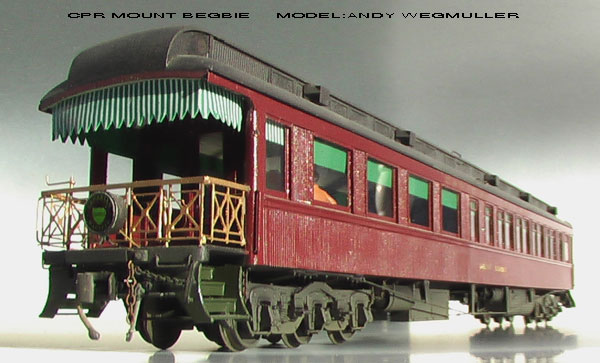 |
||
| THE PROTOTYPE In the summer 1909 the Canadian Pacific
Railway took delivery of twenty-two new observation
cars constructed of wood and steel at the company's
own Angus shops in Montreal. Eleven cars were named
after mountains and featured an observation room, a
buffet, three state rooms and one drawing room. Eleven
other cars of similar construction were named in the
"Glen" series and featured an observation room, a
buffet, a smoking room, one state room and one drawing
room. All cars were immediately put in service on
CPR's transcontinental route between Montreal and
Vancouver. Cars with such a prestigious assignment in
that time were very well built, and finished with the
finest materials and contemporary fittings.
From 1910 to 1913 the CPR built twenty - three more "Mount" cars in four series and in 1916/17 all the "Glen" cars were converted to "Mount" cars. This brought the total of "Mount" cars in service to forty - five. In this article we are focusing on the "Mount" cars, which truly represented the finest way to travel the CPR across the Canadian shield, through the Prairies and over the Rocky Mountains during the first part of this century. CPR built all "Mount" cars at their Angus shops in Montreal. Body and under frame were made of wood to contemporary construction designs at a time when coach building was at its highest level in terms of craftsman ship. |
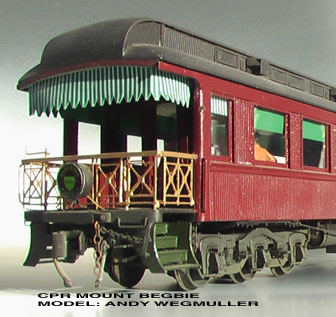
|
|
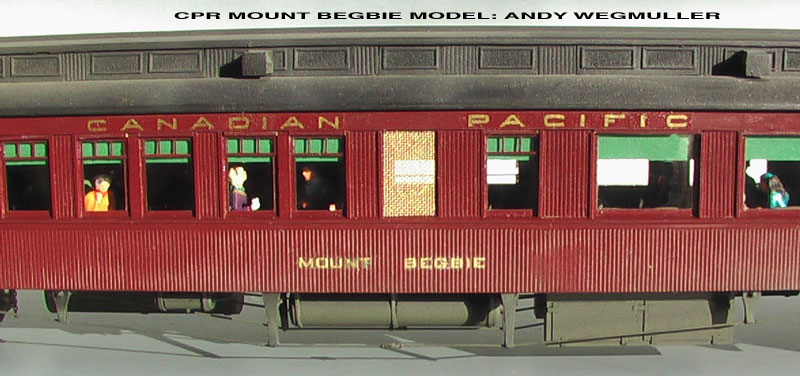 |
||
| A
few steel parts were utilized for load bearing parts on
the under frame, such as truck bolsters, truss rods,
draft gear, ect. The complete car body was made of wood,
with tongue-and-grove mahogany for the outside
sheathing. Trucks utilized were the all steel 6-wheel
type, bottom equalized "Commonwealth cast frame", with
separate cast pedestals mounting 5" x 9" journal-boxes.
Wheel diameter was 36". Total length inside coupler
knuckles was 80'-11 1/4". The observation platform at
the rear end was 6'-6" long, enclosed with a massive
brass railing and gates, and deck chairs were provided
to accommodate about 15 passengers. The observation room
provided 18 large, movable and very comfortable arm
chairs of three different designs made of padouk with
morocco leather upholstery. Small end tables held
magazines and were adorned with heavy lamps. One special
feature of these cars were the windows in the rear of
the observation room, which were designed to reach down
to 20" above the floor, enabling passengers an unbroken
view of the scenery. The walls were also finished in
padouk, a wood similar to Spanish mahogany, but of a
deeper red. Another unique feature of the "Mount" cars lay in the fact that they were the first passenger cars to be built by the CPR with electric lights. The three state rooms were 6'- 4" long by 7' wide, each with a toilet and sink. The one drawing room was of the same size but it had a sofa with the toilet and sink in a 4' long annex. A cook in the buffet section provided the passengers with snacks, light meals and cocktails. Always present was a porter, to look after the comfort of the passengers. His seat was located across the aisle from the buffet. As delivered, the outside of the cars was finished with stained and heavily varnished tongue-and-grove mahogany, adorned with lettering and decorations in genuine gold leaf and polished brass railings. Mineral brown paint was used to weather proof the canvas roof. Trucks and under carriage fittings were painted black. During World War 1, the CPR started painting all wooden passenger cars to match the new steel cars coming into service. The color chosen was a dark red, the now famous "CPR Tuscan" which was derived from a color the SOO LINE used on its passenger equipment (we can see history repeating, with CP using SOO red in its current engine paint scheme). Roofs got painted black, the same colour as the under carriage and trucks. Around this time period the CPR management decided that polished brass railings on observation cars were an unnecessary maintenance expense. It was decided to paint these railings black, excepted the top and side handrails . Needles to say, the cars lost a big part of their glamour. In this appearance they carried many lucky travelers across the country until 1925/26 when a program of steel-sheathing partially altered their appearance. With the appearance of new steel cars, the wooden observation cars in the prestigious transcontinental service had quickly gone out of style. This was undoubtedly an attempt to have them match the newly constructed heavy-weight steel "Mount" cars of 1926. However the steel-sheathed wooden "Mount" cars continued, on the transcontinental run for many years, though with less glamor than newer equipment. Particularly the "Solarium cars", introduced in May 1929. All "Mount" cars from the 1909 series were converted to coaches in 1942/43. Excepting the Mount Begbie, Mount Rundle and Mount Lefroy, which were sold to the Alberta Northern Railway. Cars from the 1910 series carried on until they were scrapped in 1956/57. Most cars from the 1911, 1912 and 1913 series were converted to hospital cars and coaches during the war in 1942/44. Only two wooden "Mount" cars have survived to this day, albeit in their steel-sheathed state. The "Mount Lefroy", which was the first one built, resides on a farm near Tofield, Alberta and is reported to be in very bad condition. The other one is "Mount Ellesmere" formerly in maintenance of way service on the Q.NS & Ly Railway as # 453. It would be nice to see one of this cars getting restored to their original appearance. |
||
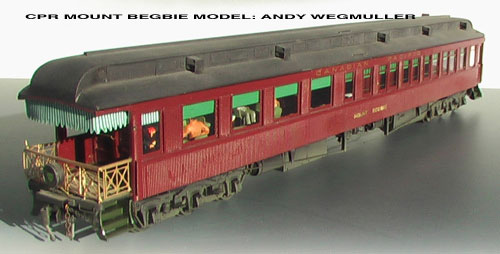 |
||
| THE HO SCALE MODEL A few years ago LANCE CAMP of Vancouver BC,
a prominent CPR historian and model collector,
acquainted me with the story of this famous but
forgotten mansions on wheels.
As I am very interested in history and heritage artifacts, and always had a great admiration for the wooden coaches of generations past, I became immediately interested. Lance needed to have an HO model of a "Mount" car for his collection. He had asked some brass importers but apparently there was no hope for a far-east brass production run. When he asked me, whether I could make one for him, I said I would think about it. Having built hundreds of architectural models in the past for customers, it promised to be a project I could hardly turn down. From the very beginning, it was clear to me, the challenge to build a successful model of this car would be great and would require extensive research, some Innovative state-of-the-art model building techniques, a lot of patience, and endurance to finish it at all. The main problem I actually faced was not really how to build the model, but to make it prototypically correct. The wooden "Mount" cars were altered and mostly scrapped before I was born, so It was not possible to study and measure the prototype as it would have appeared in the early 1920's. I agreed to accept the challenge to build the model, with the assurance that any information from authorities on the subject would be open to me. Getting started with the project required a lot of home work. First, I studied and photographed a surviving but distant relative, the wooden business car "BRITISH COLUMBIA" of 1890 vintage. This car belongs to the West Coast Railway Association (WCRA) and is on display at their beautiful Heritage Park Museum in Squamish BC. Next, I studied the possibility of rebuilding/converting an imported brass "Kettle Valley" car. But it was found that correcting the numerous mistakes on this model, and the whole rebuilding job were not justified. Instead I could build a far superior model using high tech model building techniques of the 1990's. Though this necessitated starting from scratch. And scratch it was (a lot of it on the head)! Practically no HO parts suiting the prototype are commercially available, everything had to be created by hand. For the car body, I chose to have the sides and ends fixed to the floor, but the roof removable. To make the car sides I employed the sandwich technique. Years ago, I made an 0 scale CPR open platform combine this way, resulting in windows that are crisp-clear, and very realistic in appearance. To do the same in HO scale necessitated much experience and clean working practice. Before going ahead with the "Mount" car, I decided to test the technique on a HO model of a wooden CPR day coach of the same era. It proved successful; the sides are very realistic and strong. A slab of thin 0.8 mm (0.030") acrylic plastic serves as the supporting main structure and also the window glass. Tongue-and-grove wood imitation, belt rail, letter board and window frames are made from Evergreen styrene and glued to the acryl plastic with liquid cement; a technique similar to that I always use in architectural model building. |
||
 |
||
| No
more
time was wasted getting started on Lance's "Mount" car.
Only one thing, by now my day coach needed a companion. I decided I had to build two "Mount" car models. Lance's car was to be the "Mount Cheops", a famous summit in the CPR Rogers Pass area. For my model I chose the "Mount Begbie", a legendary name in British Columbia history. The namesake peak near Revelstoke was named for Judge Matthew Baillie Begbie, first Chief Justice of British Columbia who was a legendary character in making law and order during the Cariboo gold rush in the 1860's. To save time on repetitive parts I made silicone rubber molds and cast them with epoxy resin. A challenge was to produce the brass railing for the observation platform and the distinctive CPR upper sash windows. Photo milling them out of brass was my preferred choice for these parts. With the aid of a computer, a graphic program was enlisted to make the drawings for the art work needed in using the photo milling process. For the roof I was able to use wooden roof stock made by North Eastern, though it had to be milled to the correct width for the clerestory. Roof vents and clerestory windows (screens) are castings made from my own hand made masters. The curved roof ends are castings as well, glued to the wooden roof stock, and the joint carefully filled with putty and sanded to make it invisible. Completing the "train" end (that opposite the observation end) is A Walters diaphragm, a steam hose, train and signal lines, safety chains, uncoupling rods and a Kadee coupler. Slowly the model took shape, and with all detail parts in place the day came for airbrushing it. Painted in the attractive CPR Tuscan, the crisp details now showed up nicely. The model looked much better now, than it had in the raw! For me, one of the highlights in model building lies in painting and giving a realistic look to the model. The most important job in making a model look realistic is, of course, the fine art of weathering. Contrary the popular belief among hobby painters that weathering can be used to hide a sloppy paint job, it is actually the most difficult task in painting a model. A good weathering job requires absolute control of the air brush combined with other techniques like dry brushing, that are acquired with a lot of practice. One has to study the prototype to see where dirt actually accumulates, and the right colors to represent different kinds of "dirt". Passenger cars of the wooden "Mount" car era were kept very clean, excepting an accumulation of dust and soot on the roof, and dirt and brake dust on the trucks. Airbrush weathering is easily overdone and cannot be corrected. Once too much is on the model it stays, and any painting blemishes show up to unfortunate effect. The lettering was made from my own water slide decals. |
||
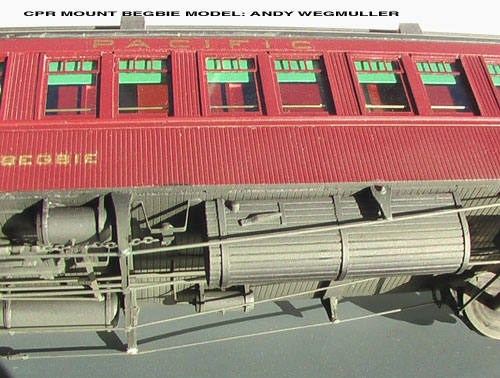 |
||
| I
think a model without interior, of such a distinguished
car would not do it justice. Fortunately, information of
the interior layout is available. I decided to build the
interior as a separate unit with floor and compartment
walls made from 0.8 mm acryl plastic. The seats are cast
with epoxy resin from my own molds and more acrylic
plastic was used for the buffet counter, desk and
cabinet . The window blinds are made from paper, air
brushed an appropriate green. In my opinion, a passenger car model without revenue producing passengers is not complete. Preiser makes some very nice sitting passengers. I got two sets of their unpainted figures and hand painted them to represent the upper class fashions of the roaring twenties; if you look really close, you can see ladies in shiny silk dresses with matching hats. Hundreds of hours were spent on this project in research and building. Looking back, I have to say it was a very rewarding project, as I learned a lot about the early CPR and met some interesting people, providing necessary information. Many TV programs were missed and with that came the realization that there is more to life than watching TV or videos! I have written this article in the hope it will inspire other young people to become modelers and to discover the heritage and the history of our railroads. More important in a personal sense, is the satisfaction of having achieved something, and the fact two people are very happy with having these "jewels of the crown" in their model collections. This challenge mastered, I am looking forward to a next project of building wooden CPR mail and baggage cars and eventually an entire CPR trans-continental train of the wood era in HO scale. |
||
| I
like to thank LANCE CAMP for giving me the opportunity
to build this model for him and for the help in
preparing this article. Many thanks also go to GIB KENNEDY of Richmond BC, who sadly passed away last summer. Gib's recollections and constructive criticism were invaluable and helped to get the model as historically accurate as possible; and to Jim Shields, Canadian Pacific Archives in Montreal for providing further advice and information. |
||
Further reference on the subject: Model Railroader June 1959: Model Railroader December 1959: Model Railroader May 1961: Model Railroader September 1966: Railroad Model Craftsman May 1990: |
||